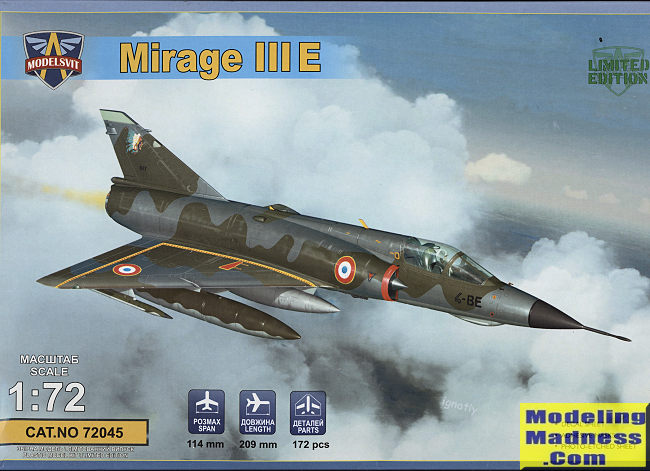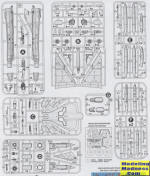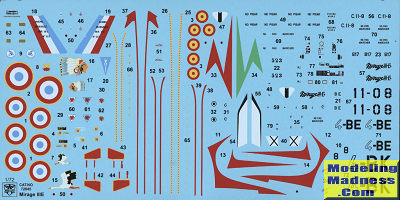
| KIT #: | 72045 |
| PRICE: | $36.99 plus shipping |
| DECALS: | Three options |
| REVIEWER: | Scott Van Aken |
| NOTES: | includes p.e. fret |

| HISTORY |
While the Mirage IIIC was being put into production, Dassault was also considering a multirole/strike variant of the aircraft, which eventually materialized as the Mirage IIIE. The first of three prototypes flew on 1 April 1961.
The Mirage IIIE differed from the IIIC interceptor most obviously in having a 30 cm (11.8 in) forward fuselage extension to increase the size of the avionics bay behind the cockpit. The stretch also helped increase fuel capacity, as the Mirage IIIC had marginal range and improvements were needed. The stretch was small and hard to notice, but the clue is that the bottom edge of the canopy on a Mirage IIIE ends directly above the top lip of the air intake, while on the IIIC it ends visibly back of the lip.
Many Mirage IIIE variants were also fitted with a Marconi continuous-wave Doppler navigation radar radome on the bottom of the fuselage, under the cockpit. However, while no IIICs had this feature, it was not universal on all variants of the IIIE. A similar inconsistent variation in Mirage fighter versions was the presence or absence of an HF antenna that was fitted as a forward extension to the vertical tailplane. On some Mirages, the leading edge of the tailplane was a straight line, while on those with the HF antenna the leading edge had a sloping extension forward. The extension appears to have been generally standard on production Mirage IIIAs and Mirage IIICs, but only appeared in some of the export versions of the Mirage IIIE.
The IIIE featured Thomson-CSF Cyrano II dual mode air / ground radar; a radar warning receiver (RWR) system with the antennas mounted in the vertical tailplane; and an Atar 09C engine, with a petal-style variable exhaust.
The first production Mirage IIIE was delivered to the AdA in January 1964, and a total of 192 were eventually delivered to that service.
Total production of the Mirage IIIE, including exports, was substantially larger than that of the Mirage IIIC, including exports, totaling 523 aircraft. In the mid-1960s one Mirage IIIE was fitted with the improved SNECMA Atar 09K-6 turbojet for trials, and given the confusing designation of Mirage IIIC2.
| THE KIT |
 I'm
no stranger to Mirage III kits having built a number in both scales. Frankly, I
like them. When I noticed that Modelsvit had done one in 1/72, I had to order a
couple. There are a number of different boxings, this one being the standard
Mirage IIIE as initially built for the French, but exported to a number of other
nations.
I'm
no stranger to Mirage III kits having built a number in both scales. Frankly, I
like them. When I noticed that Modelsvit had done one in 1/72, I had to order a
couple. There are a number of different boxings, this one being the standard
Mirage IIIE as initially built for the French, but exported to a number of other
nations.
The detailing on the parts is top rate and the sprues are free from flash. There are a lot of parts, some of them small, and typical of this sort of kit, to build up areas sometimes requires a lot of parts. For instance, the main gear wells require six parts. In order to allow maximum use of sprues with other kits, the nose is a separate piece from the rest of the fuselage.
The cockpit and nose gear assembly are a single sub-assembly with some of the p.e. bits used here, mainly for the instrument panel, side consoles, and the seat harness. You do have the option of not using the p.e. bits for the panel and consoles as decals are also included. Once all the interior bits are in place, the nose can be closed up after installing 4 grams of weight in the nose. I found it a bit odd that the radome was not a single piece but part of the forward fuselage. Interestingly the large nose gear door is molded onto each of the fuselage halves and will have to be cut away if you want this door to be posed open. Leaving it closed is not unusual, but means another seam to fill and some difficulty later on installing the nose gear retraction strut.
One then builds the exhaust and here some of the p.e. is used for additional detail. Nose gear is built and the wheel well parts installed on the lower wing. Then the inner intakes and exhaust are installed in the fuselage halves, the top cover put on the main gear wells, and the lower wing attached to the lower fuselage. Upper wing halves are installed and the nose section is slid in between the already assembled intakes. The outer intakes are molded in the fuselage halves, the first time I've seen this done on this type of aircraft. It will certainly negate the need to get a perfect intake fit as on other kits.
 Construction
then moves to the underside with the attachment of the fuselage rocket pack and
the elevon hinges. This is followed by the landing gear and the gear doors. The
kit provides both an open and closed canopy option and you are given masks for
the canopy parts. For things under wings you have three different fuel tanks,
two different missiles (Sidewinder or Matra), and a nuclear bomb for the
centerline.
Construction
then moves to the underside with the attachment of the fuselage rocket pack and
the elevon hinges. This is followed by the landing gear and the gear doors. The
kit provides both an open and closed canopy option and you are given masks for
the canopy parts. For things under wings you have three different fuel tanks,
two different missiles (Sidewinder or Matra), and a nuclear bomb for the
centerline.
Instructions are well done and provide color information using Humbrol paints. Three markings options are given. Two are French with one option in overall unpainted metal with EC 4 in 1966. The other is also with EC 4 but this time in the camouflage scheme used in 1979. In the same scheme as the 1979 French option is a Spanish aircraft from 1992. Decals are very nicely done and if you don't like the options provided, there are aftermarket sheets.
| CONCLUSIONS |
May 2024
Copyright ModelingMadness.com. All rights reserved. No reproduction in part or in whole without express permission from the editor.
If you would like your product reviewed fairly and fairly quickly, please contact the editor or see other details in the Note to Contributors.